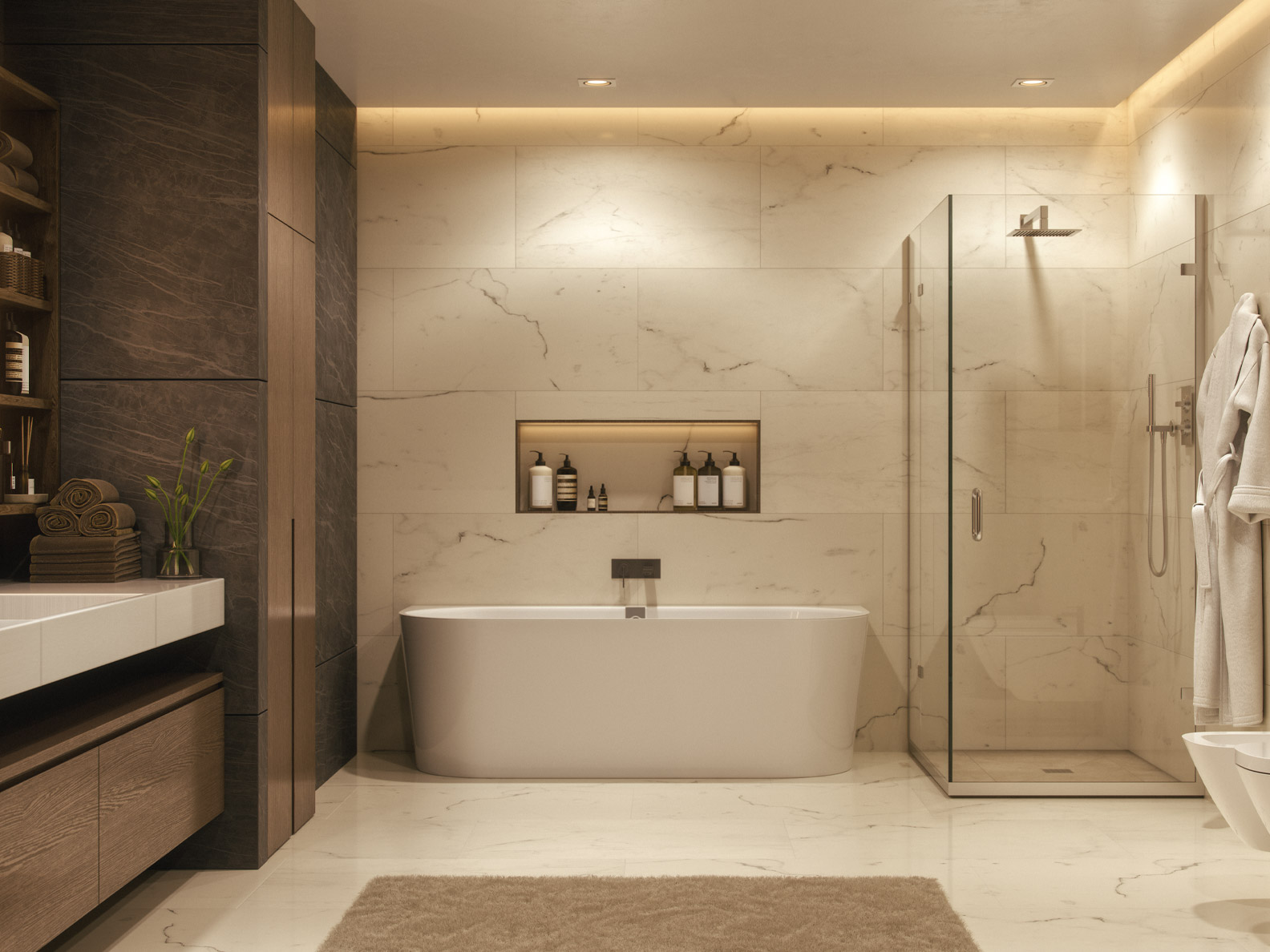Remodeling a bathroom seamlessly blends functionality with design, transforming one of the most frequently used spaces in your home into a comfortable and efficient environment. From tile selection to lighting fixtures, each decision influences both durability and appearance. Careful planning helps you avoid costly mistakes and ensures every component aligns with your style and budget.
Understanding how to choose the right bathroom remodel materials allows you to create a cohesive and lasting design. Every product, from flooring to countertops, affects water resistance, maintenance needs, and longevity. With numerous options available, a systematic approach helps you select finishes that not only look good but also perform well over time.
Step 1: Assess Functionality and Usage
Before exploring colors and textures, consider how the bathroom functions on a daily basis. A family bathroom endures more humidity and wear than a guest bath, which influences the choice of materials for bathroom remodeling. For example, porcelain tile is resistant to moisture and easy to clean, making it ideal for high-traffic areas. Natural stone offers elegance but requires sealing to prevent stains and water damage.
Consider how often you utilize the space and the challenges you currently face. Poor ventilation, slippery floors, or limited storage usually determine which upgrades take priority. Once you understand the functional requirements, material choices become more straightforward.
Step 2: Create a Bathroom Remodel Material Checklist
A detailed bathroom remodel material checklist keeps your project organized. It prevents overlooking essential components that influence cost, scheduling, and design consistency. Include every item that contributes to the finished look and usability of the room. Typical materials include:
- Flooring and wall tiles
- Paint or waterproof wall panels
- Vanity, sink, and countertop
- Bathtub or shower enclosure
- Plumbing fixtures and fittings
- Lighting fixtures
- Ventilation fan
- Mirror and accessories
- Cabinet hardware and shelving
- Grout, caulk, and sealants
This checklist also helps contractors provide accurate estimates. Missing items often lead to unexpected expenses or delays, so the more detailed the list, the smoother the renovation process will be.
Step 3: Compare Bathroom Remodel Material Cost
Understanding the cost of bathroom remodel materials helps you manage your budget effectively. Prices vary based on quality, brand, and location. For instance, ceramic tile may cost less than $3 per square foot, while marble or high-end porcelain can reach $20 or more. Vanities, countertops, and fixtures follow similar patterns, offering both budget-friendly and luxury options.
Ask suppliers for itemized quotes that include delivery fees and taxes. Some homeowners focus only on large items, such as tubs and tiles, forgetting about small yet significant components, including adhesives, grout, and plumbing connections. These smaller items make a noticeable contribution to the cost of materials for bathroom remodel projects.
Setting a clear budget early prevents compromises later. Always include a 10–15 percent contingency for unexpected costs, such as subfloor repair or upgraded plumbing parts.
Step 4: Balance Aesthetics and Performance
Visual appeal matters, but durability determines long-term satisfaction. The most beautiful tile or countertop means little if it cracks, stains, or warps after a year. Evaluate each material’s ability to handle moisture, heat, and cleaning products.
Quartz and solid-surface counters resist stains better than marble, which requires frequent sealing. Luxury vinyl tile mimics the look of wood or stone without absorbing water, making it a versatile option for both indoor and outdoor spaces. Select materials specifically designed for use in wet environments, particularly for floors and shower areas.
Lighting and color also affect perception. Light-colored surfaces create a sense of space, while darker tones add warmth and sophistication. Select finishes that reflect your style while also supporting easy maintenance.
Step 5: Evaluate Sustainable and Eco-Friendly Options
Homeowners increasingly value environmentally responsible choices. Selecting materials for an eco-friendly bathroom remodel benefits both your health and the planet. Look for eco-friendly bathroom remodeling materials certified for low emissions and responsible sourcing.
Bamboo and reclaimed wood are excellent choices for cabinetry or shelving. Recycled glass tiles provide unique patterns and reduce waste. Low-flow faucets and dual-flush toilets conserve water without compromising performance. Even paint choices matter: select low-VOC or zero-VOC products to improve indoor air quality.
When you plan sustainably, your bathroom remains functional and beautiful while reducing environmental impact. Many green materials also offer long-term savings through improved efficiency and lower maintenance requirements.
Step 6: Prioritize Moisture Control and Ventilation
Bathrooms experience constant humidity, which can damage materials that are not well-suited to withstand it. Waterproof backer boards, vapor barriers, and high-quality caulking protect against leaks and mold growth. For walls, consider using ceramic or porcelain tile that extends several inches above the tub or shower line to shield the drywall from splashes.
Ensure proper ventilation with an exhaust fan sized for your room’s square footage. Good airflow prevents condensation and extends the lifespan of finishes. Materials that resist mold, such as acrylic panels or mildew-resistant paint, enhance durability and cleanliness.
Step 7: Plan for Longevity and Maintenance
Durable materials require less maintenance and retain their appearance over time; research cleaning methods before making a purchase. For example, natural stone demands specialized cleaners, while glass and ceramic tolerate most household products. Avoid surfaces that stain easily, especially if you have hard water or experience heavy daily use.
Fixtures with solid brass interiors tend to last longer than those with plastic components. High-quality grout and proper sealing prevent water infiltration behind tiles. Choosing dependable materials may incur slightly higher upfront costs, but it saves money on future repairs and maintenance.
Step 8: Factor in Installation Requirements
Each product has unique installation needs that influence both scheduling and labor expenses. Large-format tiles reduce grout lines but require precise handling and installation. Solid-surface countertops must be cut professionally to ensure a proper fit for sinks and plumbing.
Ask contractors how installation methods affect pricing. Some materials require specialized adhesives or additional subfloor reinforcement, which increases both material and labor costs. A thorough understanding of these requirements prevents budget surprises and ensures consistent quality throughout the remodel.
Step 9: Review the Complete List of Materials Needed to Remodel a Bathroom
Before ordering, verify that your list of materials needed for a bathroom remodel includes all necessary functional and decorative elements. Cross-check measurements, quantities, and finishes to ensure accuracy and consistency. Missing items create project delays, while over-ordering wastes money and storage space.
Your finalized list should match the contractor’s quote and drawings. Pay attention to trim pieces, grout colors, and finishing accessories that tie the design together. A precise list makes purchasing efficient and reduces stress once construction begins.
Step 10: Confirm Delivery and Storage Plans
Materials often arrive at different times, so planning delivery and storage keeps the project organized. Protect fragile items, such as mirrors, tiles, or fixtures, from damage. Store them in dry, temperature-controlled areas. Label each box clearly for quick identification once installation starts.
Coordinate delivery schedules with your contractor to avoid clutter or construction delays. Reliable communication ensures every material is ready when needed, helping the remodel progress smoothly.
Bringing Your Design Vision to Life
Selecting materials defines how your finished bathroom feels and performs. A thoughtful approach blends style, practicality, and sustainability. When you analyze bathroom remodel materials through the lens of function, cost, and durability, you eliminate guesswork and make confident decisions.
Reviewing accurate bathroom remodel material cost data, creating a detailed checklist, and incorporating eco-friendly solutions result in a project that aligns with your budget and values. Whether you choose sleek modern surfaces or timeless natural finishes, the right materials transform an ordinary space into a functional retreat.
A well-planned remodel doesn’t just refresh appearances; it enhances daily living and increases home value. With careful planning, clear priorities, and quality materials, your bathroom will remain beautiful, efficient, and sustainable for years to come.
From Concept to Completion: AP Advanced Delivers Your Ideal Bathroom
At AP Advanced, every bathroom remodel should be smooth, efficient, and built to last. Serving Jacksonville, St. Augustine, Amelia Island, and surrounding Florida communities, our team is committed to delivering high-quality construction, open communication, and meticulous project coordination from start to finish.
We specialize in kitchen remodels, indoor and outdoor renovations, garage conversions, and home additions: all designed to enhance comfort, function, and value. Whether you’re updating a single space or transforming your entire home, we deliver results that align with your vision and lifestyle. Every project reflects consistency, precision, and integrity. Through organized workflows and dependable follow-through, we create spaces that are as beautiful as they are built to last.

